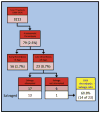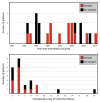Successful Salvage of Late Anastomotic Thrombosis after Free Tissue Transfer
- PMID: 26872023
- PMCID: PMC5492225
- DOI: 10.1055/s-0036-1571359
Successful Salvage of Late Anastomotic Thrombosis after Free Tissue Transfer
Abstract
Background Anastomotic thrombosis following free tissue transfer (FTT) on or after day 5 ("late thrombosis") is reported to have extremely low rates of salvage. Analysis of our institution's experience with FTT was performed to make recommendations about the optimal management of late thrombosis, and to identify any variables that are correlated with increased salvage rates. Methods The study included patients who underwent FTT between 1986 and 2014, then suffered anastomotic thrombosis on or after postoperative day 5. Twenty-six variables involving demographic information, flap characteristics, circumstances of the thrombotic event, and details of any salvage attempt were analyzed. Patients whose FTT were successfully salvaged and those whose were not were statistically compared. Results Of the 3,212 patients who underwent FTT, 23 suffered late thrombosis (0.7%), and the salvage rate was 60.8% (14 of 23). The salvage rate for reconstruction of the head and neck was 53.3%, breast was 66.7%, and extremity was 100%. There was a statistically significantly greater salvage rate in flaps performed after 1998 than in those performed before 1998 (p = 0.023). There was a nonstatistically significant trend toward increased salvage rates in patients who had no anastomotic thrombotic risk factors, reconstruction using fasciocutaneous flaps, and anastomotic revision using new recipient vessels. Conclusion Our data demonstrate that flap survival after episodes of late thrombosis can be higher than what the literature has previously reported. This underscores the importance of rigorous postoperative monitoring, as well as the importance of exploration at the earliest instance of concern for threatened flap viability.
Thieme Medical Publishers 333 Seventh Avenue, New York, NY 10001, USA.
Figures
References
-
- Kroll S, Schusterman M, Reece G, et al. Timing of pedicle thrombosis and flap loss after free-tissue transfer. Plast Reconstr Surg. 1996;98(7):1230–3. - PubMed
-
- Yoshimotoa S, Kawabataa K, Mitani H. Analysis of 59 cases with free flap thrombosis after reconstructive surgery for head and neck cancer. Auris Nasus Larynx. 2010;37(2):205–11. - PubMed
-
- Kadota H, Sakuraba M, Kimata Y, Yano T, Hayashi R. Analysis of thrombosis on postoperative day 5 or later after microvascular reconstruction for head and neck cancers. Head Neck. 2009;31(5):635–41. - PubMed
-
- Yu P, Chang DW, Miller MJ, Reece G, Robb GL. Analysis of 49 cases of flap compromise in 1310 free flaps for head and neck reconstruction. Head Neck. 2009;31(1):45–51. - PubMed
MeSH terms
Grants and funding
LinkOut - more resources
Full Text Sources
Other Literature Sources
Medical



